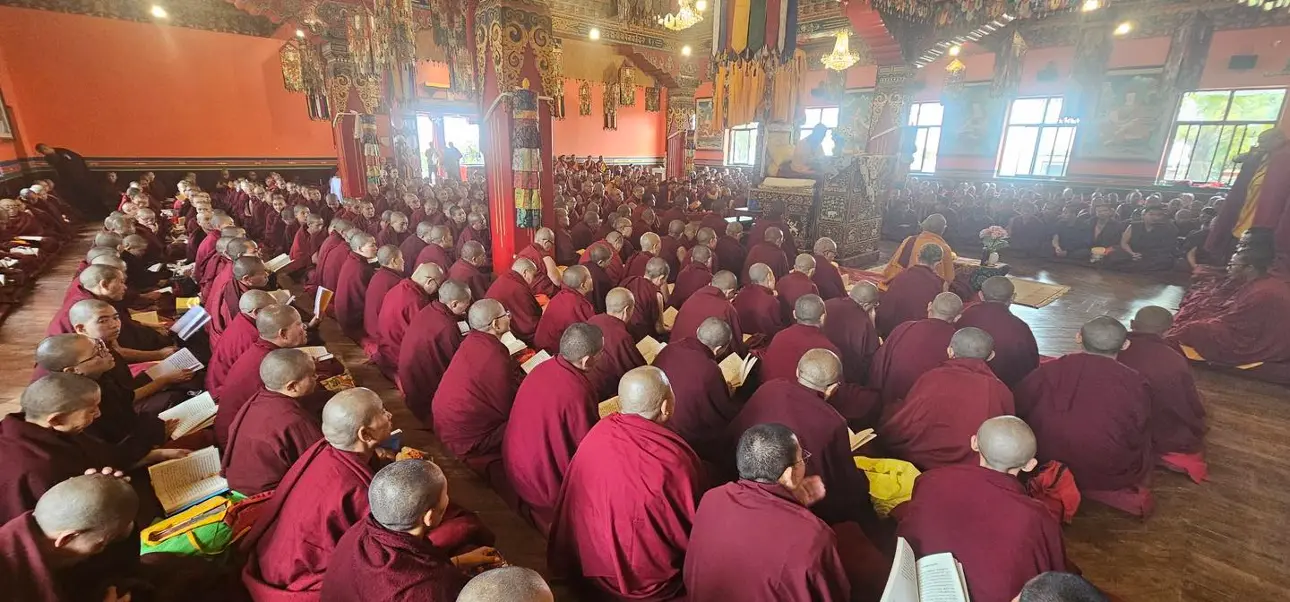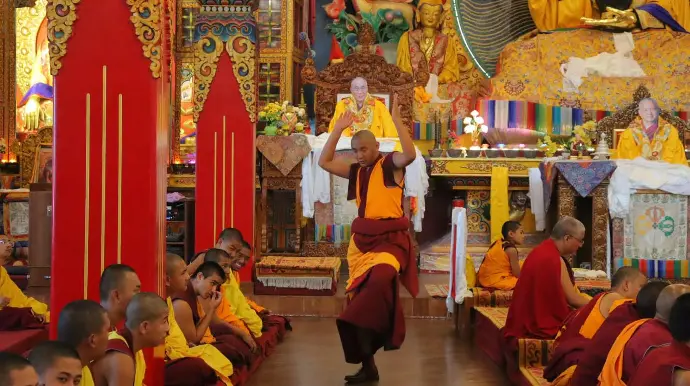Calendar Of Monastic Events
The monastic year is marked by a series of rituals and ceremonies that remind the community in many different ways of their shared path and goals. Some of the events are dictated by the Tibetan culture, such as the New Year celebration, other are according to the monastic calendar, or they commemorate specific religious events important to the community.
1. LOSAR – TIBETAN NEW YEAR

In the week preceding Losar, a special day is set aside for cleaning the house and all possessions. At the monastery the gompa is vigorously cleaned, ritual objects as well as statues, including the chandeliers high up on the ceiling. All the brocades are put out in the sun for a good airing, including the huge hat of the Lama Tsong Khapa statue. The smell of khabse, a traditional new year sweet pastry, drifts through all the halls and rooms.
Purification rituals (Gyutor) mark the end of the Tibetan year, culminating in a day of prayers and ritual dances. A huge torma (ritual cake), symbolizing all negative actions of the past year, is placed in the court yard. After blessing the torma, it is carried in a procession to the surrounding fields and offered to the fire.
On the first day of the Tibetan New Year the community gets together in a special puja to celebrate and bless the coming year. Khatas (ceremonial scarves) are offered to the teachers and everybody takes part in tasting the barley grain and flour, a staple food from Tibet, which is auspicious for prosperity and good luck in the New Year. Lots of Kabse and Tibetan tea are offered during the puja, after which everybody gathers for lunch before going for visit their families and friends.
Read more about Losar - The Tibetan New Year
2. Monlam – The Great Prayer Festival

The Great Prayer Festival was established by the founder of the Gelug Lineage of Tibetan Buddhism, Lama Tsong Khapa (also known as Losang Drakpa) in 1409, when the first Great Prayer Festival was held in Lhasa. The tradition continues right through to the present day in the monasteries in India and Nepal.
Kopan Monastery has been hosting this annual Prayer Festival, with thousands of monks and nuns as well as large numbers of lay people attending the daily prayers and teachings. On the main day of the festival, the Day of Miracles, extensive offerings are made by the lay population in order to create merit. The Great Prayer Festival ends with a special Maitreya Buddha day, during which prayers are made to Maitreya Buddha, requesting him to return quickly, and statue of Maitreya Buddha is carried in a procession around the monastery grounds. This noble tradition is preserved and practiced in the same way to this day in most of the Gelug monasteries. Held on the full moon day of the first Tibetan Month, the Day of Miracles is the most special day of the festival where thousands of people, lay and ordained alike, come to pray, view the big butter sculptures and the large thangkas, and make offerings to the Sangha.
The main purpose of the Great Prayer Festival is to pray for the long life of all the holy gurus of all traditions, for the survival and spreading of the Dharma in the minds of all sentient beings, and for world peace. The communal prayers, offered with strong faith and devotion help to overcome obstacles to peace and generate favorable conditions for everyone to live in harmony.
Read more about the The Great Prayer Festival at Kopan.
3. Tsip Shag

Moving to a higher class
In this ceremony, the students gather by class in the courtyard, 4 - 5 students at a time, to receive the oral transmission (lung), from the abbot of the text they will study in the coming year. This is a very moving occasion - it also signifies progressing to a higher class. This is also the time when the participants for the Rigjung Debate are chosen.
After the transmission, the class groups will sit together in the courtyard and recite the oral transmission three more times, to create merit for achieveing the higher class. In the great monasteries, this is done on a monthly basis, whereas at Kopan it is done once a year.
4. Surkor Puja
Entering Surkor class
After having completed the Minor Field of Study (Rigjung), students enter into the higher section of their studies (Surkor means four texts). To complete the extensive philosophy studies successfully, a large amount of positive potential is needed. Before entering the Surkor section of their studies, the respective groups of monks stay together closely for a week, doing extensive prayers and pujas, to gather merit, and to purify obstacles that might arise with the study of these texts. Extensive offerings are made to the monastery also for this purpose. This ceremony is repeated before entering the Pharchin and the Madyamika section of the study.
5. Rigjung Debate

Rigjung Debate is an important event in the academic year. With it the first part of the monastic studies is concluded, and the students enter into the higher studies. Rigjung marks the completion of the "Minor Field of Studies", which form the first part of the geshe studies, a milestone in the philosophical training of the monks and a yearly event in the monastic calendar. During the Tsip Shag ceremony, the participants of this debate are chosen. Only the top four students of the class qualify for this honor.
Read more on Rigjung Debate here
6. Observance of the Annual Rains Retreat - Yarne and Gaya
In the Tibetan 6th month the traditional rains retreat is held. For six weeks, which falls during the monsoon time in Asia, the monks and nuns stay in their home monastery in semi retreat, spending their entire time in study and practice. They will avoid walking on the grassy ground so as to not kill small insects that are around in abundance during monsoon, following the example of Shakyamuni Buddha. During his time the monks used to wander around throughout the year to different places teaching and practicing. During monsoon time they would all gather in one place, to listen to Shakyamuni Buddha's teachings, discuss matters of their community, and make extensive prayers. Food and shelter would be provided by a benefactor of the Buddha. At the conclusion of the retreat everybody enjoys a five-day holiday with visits to families and a well-deserved rest after an intensive period of study and practice.
7. Ganden Ngamchoe - Lama Tsong Khapa Day

Towards the end of the year a special day is dedicated to Lama Tsong Khapa, the founder of the Gelug school of Tibetan Buddhism. Elaborate offering rituals mark the day. The buildings are all clad in shimmering lights, giving the grounds the appearance of a fairy land. The highlight for young and old is the candlelight procession around the monastery grounds with bells and cymbals and chanting of the mantra of Lama Tsong Khapa reverberating around the hills. Lama Zopa Rinpoche advises to make 1000 light offerings on that day, and to pray to become like Lama Tsong Khapa, a great yogi and scholar.
Read more about Lama Tsong Khapa here
8. JANG GUNCHO ANNUAL INTER-MONASTIC DEBATE

In Tibet the monks of the three great monasteries (Sera, Drepung and Ganden) used to get together during the winter months for a one-month long debate. This debate was a very famous event in Tibet, with laypeople coming to watch the best debaters in action. This inter-monastic debate was re-established in South India, and now is also a yearly event for the Gelug monasteries in Nepal.
Read more about the Annual Jang Gunchok Debate
9. Special Days of the Buddha – The commemoration of the Buddha's holy deeds

These special days commemorating the five special deeds of Shakyamuni Buddha s are observed through prayers and spiritual practice on the respective days according to the Tibetan calendar. The special days are:
Day of Miracles: Buddha Shakyamuni performed miracles for five consecutive days in a contest with followers of another belief.
Saka Dawa: on this day Buddha Shakyamuni attained Enlightenment under the Bodhi Tree.
Chokar Duchen: Buddha Shakyamuni turned the Wheel of Dharma for the first time, giving teachings to his first disciples.
Lha Bab Duchen: Buddha Shakyamuni went to Tushita Pure Land to give teachings to his mother who had been reborn there.
Special Buddhist Days on the meaning of these special days and what practices you can do.
In this way the tradition of the Buddha's teachings on monastic discipline (Vinaya) are upheld and preserved.